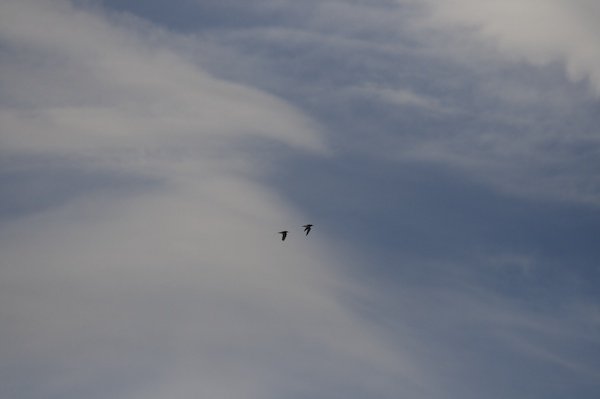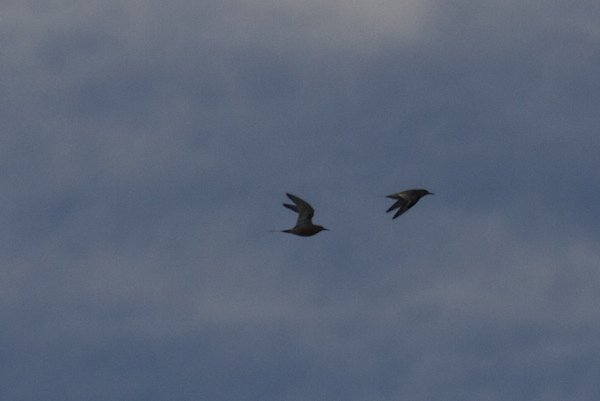Some times you just need to be lucky to find something truly amazing, the one in a million occurrence. Serendipity is a big part of the wow moments in watching nature at times, finding the unexpected.
One of my favourite places to watch bird life up here is the outflow of Marcil Lake. Marcil Lake is the source of our drinking water in Arctic Bay, and the pump house is located there, meaning that the site is very accessible. For the uninitiated (which I’m assuming is most of you) our water is trucked to our homes. Each home has a water tank and a truck delivers water, which eventually ends up in another tank in our home, the sewage tank. Another truck comes and hauls away the contents of that tank.
Now the reason for this is simple, the ground here is permanently frozen. Pipes cannot be laid in the ground, meaning any pipes have to be installed above ground, and involves costly insulation and heating to keep water in them moving. Most communities up in the Arctic go the route of having water and sewage trucked, rather than a utilidor (above ground pipe) system. What this means in terms of birds though is that I can drive right up to some of the best birding in the High Arctic, and my family and I make that trip almost every day during the breeding season.
In early June this past year, my wife and I had driven out and I was surprised to see a Semipalmated Plover (Charadrius semipalmatus) hanging about on the road. Now up until a couple of years ago conventional wisdom held that the small banded plovers found on the north half of Baffin Island were Common Ringed Plovers (Charadrius hiaticula) and Semipalmated Plovers were found on the southern half of the island. But then I discovered that a loose colony of plovers in nearby Nanisivik were in fact Semipalmated and that both species make their homes here. Being that they are practically identical it makes for challenging identification.
I snapped off some quick photos of the bird and as it moved away I got out of the truck and began following it, trying to get closer for some better shots. As I was doing that two more shorebirds flew high over head. I quickly fired off a half dozen photos hoping to identify the caldrids later, and then turned my attention back to the Semipalmated Plover.
When later came around and I blew up the images of the two birds to figure out what they were, something struck me as quite odd. The birds, it turned out, were Red Knots (Calidris canutus). That in itself was very interesting, for while they breed in the High Arctic the only place I’d seen them was flying over Lancaster Sound far out past the Floe Edge. But in every image that I took of them, barely visible but still distinct, was something trailing behind each bird. Now I had a puzzle on my hands.
I mulled over various possibilities, I thought it perhaps was grass, but although I didn’t know about Red Knots, most shorebirds don’t build nests, at least not in the traditional sense. But some birds, at least some songbirds use grass in breeding rituals. I also worried that it might be fishing line, but it appeared to be too thick for that to be the answer. I was, quite simply, stumped.
I sent the photos to some friends, and one of them, Dick Cannings, came back with the suggestion that the birds were trailing antennae from radio tags. And the more I talked to others the more that possibility became the dominant theory. So I started looking further.
Now as most of you know Red Knots that migrate along the eastern coast of North America are a cause for concern. Numbers have plummeted in recent years, and there is great interest in them in ornithological circles. And as I researched more I discovered that out of the 14,000 or so birds that staged along the Atlantic seaboard 20 had been radio tagged last year. Twenty Red Knots radio tagged by the Nature Conservancy in Virginia, and that was it.
Twenty Red Knots radio tagged and I had apparently seen two of them, flying as a pair. After a journey of some four or five thousand kilometres from the Virginia Coast Reserves to Arctic Bay, that for two of them to have apparently paired up, and then flown over the one person in hundreds of kilometres who would wonder what species they were, and who happened to have in his hands a camera and lens capable of resolving the wires on their backs, is staggering.
Fortune may favour the prepared, but it sometimes still requires a pretty large throw of the dice. I still shake my head in wonder.
















Hi Claire,
I enjoy your blog and articles so much. Thank you for sharing. If you ever want to come to the States, We are presently in North Carolina, and plan to move to the Upper Peninsula of Michigan as soon as we can sell the house. It’s too hot and crowded down here. You and you family would be welcome guests at either place. I know it’s a long way, but you never know!
We send you all our best wishes.
Dawn and Bob
Thank you Dawn and Bob. I appreciate the offer. We don’t get the opportunity to travel much because of the cost, and when we do we’re most likely off to Manitoba to see my family. But like you say “you never know!”
Nice post Clare. My camera is in my truck whenever I am. You never know and luck is no good if you’re not prepared.
Thanks Dave. It makes a big difference having a camera with you for sure. But for the plover I would have probably missed the Red Knots.
That is very lucky indeed. You need to update wikipedia’s entry for “luck”!
Have you contacted the researchers who have radio tagged the Knots?
Hi Jochen.
Yes I am in contact with them. The Nature Conservancy and Virginia Tech were the ones who tagged the 20 Knots, no others were radio tagged last year. It looks as though no one is planning on doing it this year. I had endevoured to relocate the birds to get their leg tag numbers but was unsuccessful. I also have tried to get a radio receiver to help in the future, so far without success.